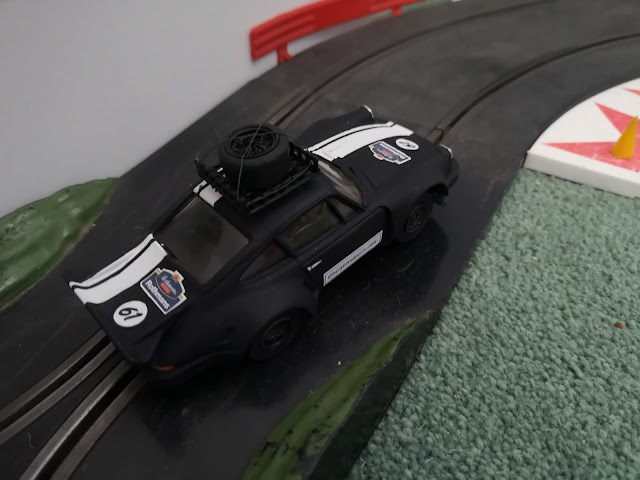Even when I was a kid, I liked the idea of weathering models to create a more realistic and less plastic looking toy. Unfortunately I wasn't very good at it then (no online tutorials to read..) and for this poor old Scalextric Capri I used sandpaper and a scalpel to physically distress the model. It's taken me some time to restore this one. Here's how it looked when I recovered it from my parents loft:
As always I researched inspiration and looked for a classic Capri design that i could work towards and in this case went for the following due to it's strong pattern and complementing colour scheme.
I added some plasticard to the front to make new raised indicators and a space for the lights (more on that later) and glued together some of the cracks and splits:
I handpainted the wheels white as to match my image above:
I went about sanding and polishing the body to get it as smooth as possible again, removing evidence of my old approach. I then added some plasticard to create some raised indicators and found some circular red plastic bits to make the fog lights. Here you can see the first application of white primer too. It received two coats of spray primer with a fine sanding in between:
For the lights I decided I didn't want to have just flat shapes and ust by chance, when in Hobbycraft buying some tie-die for my daughters I saw these adhesive gems for a few quid. perfect:
Here you can see them applied (slightly later in the build process):
The interior of the Capri also needed some updating, so it was primed black and then the driver was hand-painted with acrylics:
And then came the lengthy process of painting the bodywork using Halfords car spray, masking tape and (eventually) some freehand..
As you can imagine it was very difficult to get exactly perfect straight lines with the masking tape as there was always some bleed of white into blue or vice versa. Eventually I just used some Tamiya clear blue and painted a straight edge along the masking tape and then did the same with the white! I think an airbrush may be needed going forward....
And then came a first for me, some soldering! I picked up a cheap solder iron from Amazon and reconnected the damaged wires to the motor. Amzaingly this worked first time and the car was functioning after 30 odd years! However the rear pinion was split and this was also changed to a new one:
One of the last bits of model-making problem solving was going about replacing the damaged windscreens. I thought about molding and then casting in thin resin, tried warping transparent plastic packaging with a hair drier and eventually plumped for the less ambitious but perfectly acceptable cutting out of acetate and vigourously gluing it into the curved shape of the windscreens:
Here's the completed bodywork with old Scalextric decals applied; the Ford logo, registration plate and the car's rally number on the side. Those stripes were fucking fiddly:
And finally ready for a few coats of satin lacquer:
And here on the race track:
The painting on the bodywork doesn't stand up to close scrutiny, but it will pass for now with the materials i had to hand. Getting perfectly straight lines on patterns is a real pain in the arse and has convinced me that an airbrush is essential. Next time I would also like to make my own decals using the appropriate inkjet paper to fully personalise our cars.. I've got two more restorations in progress, that I will share another time; a Metro and an Escort.












































